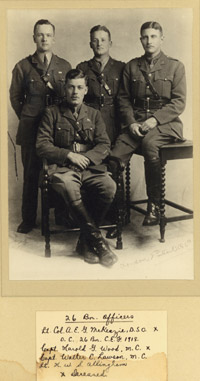|  The
First World War was a cataclysmic event, destroying body and mind
in the millions, ruining Europe's cultural outlook, engendering
deep hatreds and leading directly to the Second World War a generation
later. Canada suffered too - thousands of deaths, maimings, mental
breakdowns, suicides, war widows and spinsters waiting for loved
ones who never came home. Yet we were not the Europe of a devastated
landscape but a small and growing country soon to welcome many of
those wishing to escape a war torn continent. Canada emerged from
the First World War a more confident, independent entity, the result
of a significant commitment of human and material resources, shared
identity, victory on the battlefield and the inevitable sacrifice
those victories entailed. Canada lost over 65,000 men and women
in the conflict, mostly in the Army, but also the Royal Flying Corps
and the Royal Canadian Navy. New Brunswick was a strong pillar of
this national stretch to maturity and in the process became a microcosm
of The
First World War was a cataclysmic event, destroying body and mind
in the millions, ruining Europe's cultural outlook, engendering
deep hatreds and leading directly to the Second World War a generation
later. Canada suffered too - thousands of deaths, maimings, mental
breakdowns, suicides, war widows and spinsters waiting for loved
ones who never came home. Yet we were not the Europe of a devastated
landscape but a small and growing country soon to welcome many of
those wishing to escape a war torn continent. Canada emerged from
the First World War a more confident, independent entity, the result
of a significant commitment of human and material resources, shared
identity, victory on the battlefield and the inevitable sacrifice
those victories entailed. Canada lost over 65,000 men and women
in the conflict, mostly in the Army, but also the Royal Flying Corps
and the Royal Canadian Navy. New Brunswick was a strong pillar of
this national stretch to maturity and in the process became a microcosm
of  social
change affecting the young Dominion. The war began in a familiar
way, another call to arms from Britain in August of 1914 and a predictably
enthusiastic response. Yet as this response deepened in the opening
years of the war there grew new plants from deep seeds - an infantry
battalion of Acadian volunteers, the 165th ; black New Brunswickers
from Saint John and Fredericton joining the No. 2 Construction Battalion
being raised in Halifax, and women shipping overseas as nursing
sisters in the Royal Canadian Army Medical Corps. The Army, as senior
service, received the most recruits and its major provincial element,
the 26th Battalion, was formed with contributions from around New
Brunswick. As part of the 2ndCanadian Division, the 'Fighting 26TH"
earned its battle honours and scars in all the major conflicts involving
the Canadian Corps from the Somme to Vimy to Canal du Nord. Some
New Brunswick soldiers transferred to the young Royal Flying Corps
of the British Army, a few civilians enlisted in the small Royal
Canadian Navy and others, including many women, worked to suppport
them in factories at home. The war ended in November of 1918 and
the victory parades that followed brought together spectators and
returning veterans in celebrations that masked the many socio-economic
transformations yet to come. social
change affecting the young Dominion. The war began in a familiar
way, another call to arms from Britain in August of 1914 and a predictably
enthusiastic response. Yet as this response deepened in the opening
years of the war there grew new plants from deep seeds - an infantry
battalion of Acadian volunteers, the 165th ; black New Brunswickers
from Saint John and Fredericton joining the No. 2 Construction Battalion
being raised in Halifax, and women shipping overseas as nursing
sisters in the Royal Canadian Army Medical Corps. The Army, as senior
service, received the most recruits and its major provincial element,
the 26th Battalion, was formed with contributions from around New
Brunswick. As part of the 2ndCanadian Division, the 'Fighting 26TH"
earned its battle honours and scars in all the major conflicts involving
the Canadian Corps from the Somme to Vimy to Canal du Nord. Some
New Brunswick soldiers transferred to the young Royal Flying Corps
of the British Army, a few civilians enlisted in the small Royal
Canadian Navy and others, including many women, worked to suppport
them in factories at home. The war ended in November of 1918 and
the victory parades that followed brought together spectators and
returning veterans in celebrations that masked the many socio-economic
transformations yet to come.
Back to top
|